Accept all cookies Accept only essential cookies See our Cookie Notice

About ESA
The European Space Agency (ESA) is Europe’s gateway to space. Its mission is to shape the development of Europe’s space capability and ensure that investment in space continues to deliver benefits to the citizens of Europe and the world.
Highlights
ESA - United space in Europe
This is ESA ESA facts Member States & Cooperating States Funding Director General Top management For Member State Delegations European vision European Space Policy ESA & EU Space Councils Responsibility & Sustainability Annual Report Calendar of meetings Corporate newsEstablishments & sites
ESA Headquarters ESA ESTEC ESA ESOC ESA ESRIN ESA EAC ESA ESAC Europe's Spaceport ESA ESEC ESA ECSAT Brussels Office Washington OfficeWorking with ESA
Business with ESA ESA Commercialisation Gateway Law at ESA Careers Cyber resilience at ESA IT at ESA Newsroom Partnerships Merchandising Licence Education Open Space Innovation Platform Integrity and Reporting Administrative Tribunal Health and SafetyMore about ESA
History ESA Historical Archives Exhibitions Publications Art & Culture ESA Merchandise Kids Diversity ESA Brand Centre ESA ChampionsLatest
Space in Member States
Find out more about space activities in our 23 Member States, and understand how ESA works together with their national agencies, institutions and organisations.
Science & Exploration
Exploring our Solar System and unlocking the secrets of the Universe
Go to topicAstronauts
Missions
Juice Euclid Webb Solar Orbiter BepiColombo Gaia ExoMars Cheops Exoplanet missions More missionsActivities
International Space Station Orion service module Gateway Concordia Caves & Pangaea BenefitsLatest
Space Safety
Protecting life and infrastructure on Earth and in orbit
Go to topicAsteroids
Asteroids and Planetary Defence Asteroid danger explained Flyeye telescope: asteroid detection Hera mission: asteroid deflection Near-Earth Object Coordination CentreSpace junk
About space debris Space debris by the numbers Space Environment Report In space refuelling, refurbishing and removingSafety from space
Clean Space ecodesign Zero Debris Technologies Space for Earth Supporting Sustainable DevelopmentLatest
Applications
Using space to benefit citizens and meet future challenges on Earth
Go to topicObserving the Earth
Observing the Earth Future EO Copernicus Meteorology Space for our climate Satellite missionsCommercialisation
ESA Commercialisation Gateway Open Space Innovation Platform Business Incubation ESA Space SolutionsLatest
Enabling & Support
Making space accessible and developing the technologies for the future
Go to topicBuilding missions
Space Engineering and Technology Test centre Laboratories Concurrent Design Facility Preparing for the future Shaping the Future Discovery and Preparation Advanced Concepts TeamSpace transportation
Space Transportation Ariane Vega Space Rider Future space transportation Boost! Europe's Spaceport Launches from Europe's Spaceport from 2012Latest

High-gravity water waves
Thank you for liking
You have already liked this page, you can only like it once!
What might look like jelly being stirred is actually water subjected to 20 times normal Earth gravity within ESA’s Large Diameter Centrifuge – as part of an experiment giving new insight into the behaviour of wave turbulence.
This research, led by Stéphane Dorbolo of University of Liège and Eric Falcon of CNRS and University of Paris, has been published in the prestigious Physical Review Letters.
Wave turbulence occurs anywhere where a set of random waves interact with each other – from the ocean to the atmosphere, or in plasmas – but the exact mechanisms behind it are only dimly understood. For surface waves on a liquid, gravity dominates the behavior at low frequencies, while ‘capillary action’ based on surface tension becomes more important at high frequencies.
To increase the range of frequencies where waves are dominated by gravity, the researchers conducted their experiment in the ESA’s Large Diameter Centrifuge (LDC) where they can create effective gravity levels up to 20 times that of Earth’s gravity.
Within this extended range, the result was a surprise: the typical timescales of wave interactions and dissipation did not depend of the wave frequency, as predicted theoretically.
Instead these timescales are set by the longest available wavelength within the system – namely the size of the container the waves occur within, an effect that current wave turbulence theories does not take into account.
Prof. Falcon explains: “This result suggests that ‘container’ size needs to be considered in studies of water waves within an ocean—as well as atmospheric waves on Earth and magnetically confined plasma waves as in fusion experiments.
“Notably, this experiment serves to complete the scientific picture of how gravity has an impact on surface wave turbulence, because tuning the gravity level to an opposing low value has already been performed in experiments in zero-G parabolic flights in 2009 and more recently aboard the International Space Station in 2019. This has allowed us to successfully observe pure capillary wave turbulence with no contribution from gravity.”
Operating within a sci-fi style white dome, the LDC is an 8-m diameter four-arm centrifuge that gives researchers access to a range of hypergravity up to 20 times Earth gravity for weeks or months at a time. At its fastest, the centrifuge rotates at up to 67 revolutions per minute, with its six gondolas placed at different points along its arms weighing in at 130 kg, and each capable of accommodating 80 kg of payload.
The LDC was made available for this experiment through the Continously Open Research Announcement of the SciSpace Programme, supported by ESA’s Directorate of Human and Robotic Exploration.
-
CREDIT
ESA -
LICENCE
ESA Standard Licence
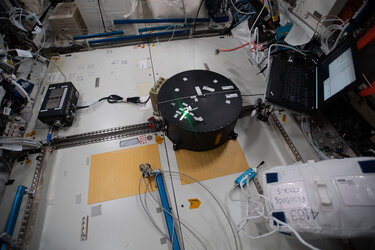
Making waves in space
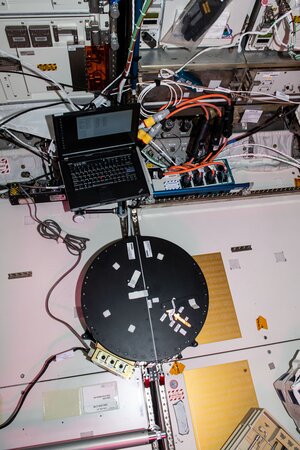
Installation of the Fluid Dynamics in Space experiment
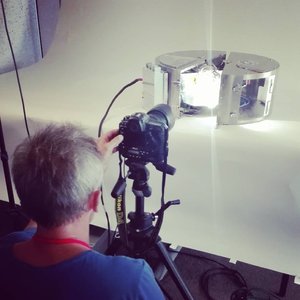
Fluidics hardware photo shoot
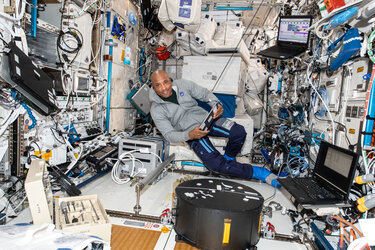
Keeping it fluid
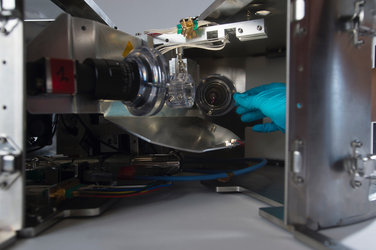














 Germany
Germany
 Austria
Austria
 Belgium
Belgium
 Denmark
Denmark
 Spain
Spain
 Estonia
Estonia
 Finland
Finland
 France
France
 Greece
Greece
 Hungary
Hungary
 Ireland
Ireland
 Italy
Italy
 Luxembourg
Luxembourg
 Norway
Norway
 The Netherlands
The Netherlands
 Poland
Poland
 Portugal
Portugal
 Czechia
Czechia
 Romania
Romania
 United Kingdom
United Kingdom
 Slovenia
Slovenia
 Sweden
Sweden
 Switzerland
Switzerland
























